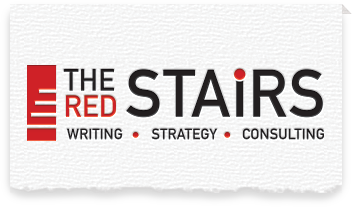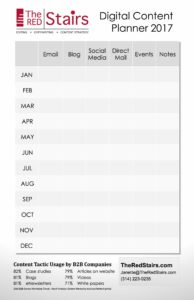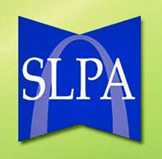For me, January is for planning. The year ahead is fresh and new, and it is time to get organized. As a company that lives by content writing deadlines, that means knowing what work is coming up and when it is due.
We use the same planning method for our writing and content marketing clients, as we do for The Red Stairs.
You can get a free copy of our 2017 digital content marketing planner here.
The big-picture content marketing planning methods that failed
We’ve tried lots and lots of different methods.
Like the year we created Gantt charts for every project. Those are the charts that show start and end dates and all the milestones in between.
The document was amazing but it was much too complicated to give us the kind of high-level, at-a-glance information we really needed… so we never looked at it.
Another time, we tried Google calendar. Again, the calendar was valuable, but as the year moved forward we began to second guess the schedule, and our color coding was a lot less helpful than expected.
We still use Gantt charts to create detailed plans for large projects, and we use a shared calendar for scheduling, but neither of these methods help us really see the big picture.
The best content marketing planning method
So, what is the solution to creating a useful content marketing planner, that you will use throughout the year and that will help to keep you on track?
The answer may surprise you – we use a big sheet of paper and a handful of Sharpies, and we make a wall chart.
Click here for a copy of the chartWhy a content marketing planner wall chart works so well?
It works because it is simple and it gives you the big picture. You just fill in the deadlines and your brain – or internal panic monster – will do the rest.
For example, on April 12 and 13, 2017, The Red Stairs will be exhibiting at MDMC2017 (Midwest Digital Marketing Conference 2017) in St. Louis, MO, and I will be speaking on a panel about content strategy.
But that is not all I have going on in April. At the end of the month, I expect to speak at the Society of Professional Journalists Regional Conference, and I have a second quarter marketing campaign planned to promote The Red Stairs.
With so much going on in April, it is easy to see we will be busy, and we should get started on this work early. After all, our client work does not stop just because we are doing some promotions. We still have to write website content, monthly newsletters, case studies, blog posts and lots and lots of other content marketing materials for our clients. Our clients depend on us to manage their schedules and deliver on time.
In fact, to make sure our client work is front and center, we add their major deadlines to the planner too. We use a different color pen for each client. For project deadlines not quite set in stone, we use Post-it notes because they are easy to move.
And, as the year goes by and new work comes up, I can glance at our wall chart and say to my client with confidence “Yes, we can complete your job by your deadline,” because I know what else is due and I can see any potential trouble spots.
Six reasons why a content marketing wall chart beats other planning methods when you need to see the big picture
- Adding to it is easy – just grab a pen and write the new project on the chart.
- You can see the whole year at once.
- You can clearly see bottlenecks.
- It is on the wall, so you see it every day. In other words, it is not hidden in a file on your computer or an app on the cloud.
- There is no login to remember.
- You don’t need Wi-Fi to check it.
If you’d like a blank copy of our chart so you can do your own big picture plan, you can get it here.
Get a FREE copy of the 2017 Digital Content Planner


 Society of Professional Journalists (SPJ) Board Member since 2012
Society of Professional Journalists (SPJ) Board Member since 2012 Society of Professional Journalists (SPJ) Board Member since 2014
Society of Professional Journalists (SPJ) Board Member since 2014 American Copy Editors Society (ACES)
American Copy Editors Society (ACES)
